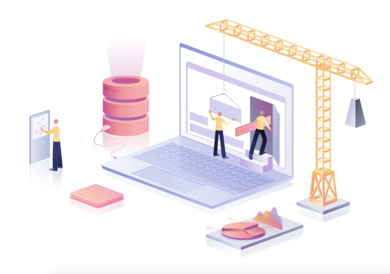.png)
In today’s digital commerce, technology alone doesn’t set platforms apart - integration does. The e-commerce leaders we see growing fastest aren’t necessarily those adding more features or vendors; they’re the ones who’ve figured out how to make everything work together. Smooth integrations, fast automation, and deep system connectivity - that’s what’s driving real growth right now.
Custom integrations (the seamless links between systems like ERPs, CRMs, logistics APIs, tax engines, and compliance tools) have quietly become the hidden growth drivers behind scalable marketplaces.
This article explores why integrations are at the core of e-commerce growth, the types every platform needs, and how leading marketplaces leverage them to outperform competitors.
Why integrations are the key to scaling marketplaces
Every e-commerce platform, from niche B2B marketplaces to global consumer giants, faces the same challenge: operational complexity grows exponentially with each new vendor, channel, and region.
Manual workflows break down quickly. Without integrations, operations depend on spreadsheets, repeated data entry, and endless synchronisation between disconnected systems - a bottleneck to scaling.
Integrations enable three critical advantages:
| Benefit | Description | Example |
| Automation | Reduces manual work by syncing product data, orders, and inventory between systems. | Auto-syncing order data from Shopify to ERP. |
| Real-time visibility | Ensures every department (sales, logistics, finance) sees the same up-to-date information. | Live stock updates across warehouses. |
| Customer experience | Enables fast shipping, accurate billing, and transparent tracking. | Real-time delivery status via carrier API. |
A marketplace that integrates efficiently can scale from hundreds to thousands of vendors without increasing its headcount at the same rate. That’s why integrations aren’t just technical add-ons - they’re core infrastructure for growth.
Let’s build the integrations that help your platform grow
Contact UsTypes of integrations every platform needs
Building a future-ready e-commerce ecosystem means connecting all the tools and processes that drive commerce: from inventory to payments, logistics to compliance. Below are the integration types that power most modern platforms.
ERP & accounting integrations
An ERP integration connects your online sales channels to the central system that manages finance, procurement, and supply chain. It synchronises data automatically, removing human error and delay.
Typical use cases:
● Syncing product SKUs, descriptions, and prices between ERP and storefronts.
● Automating invoice generation and reconciliation.
● Consolidating multi-channel sales into unified accounting records.
| Integration type | Key benefit | Popular tools |
| ERP | Centralises data across departments. | SAP, Oracle NetSuite, Microsoft Dynamics |
| Accounting | Automates financial processes and reduces reconciliation errors. | QuickBooks, Xero, FreshBooks |
Without this integration, marketplaces face delayed financial reporting, stock mismatches, and frustrated vendors. With it, every transaction becomes traceable, auditable, and real-time.
Logistics & carrier integrations
Logistics APIs are the backbone of customer satisfaction. From the moment an order is placed to its delivery confirmation, integration with carriers ensures transparency and speed.
Benefits:
● Instant shipping label generation.
● Live tracking updates for customers and vendors.
● Automated returns processing.
| Carrier API | Primary function | Typical integration |
| FedEx / UPS / DHL | International shipping and customs. | Auto-calculation of shipping rates. |
| Shippo / EasyPost | Unified API for multiple carriers. | Aggregated shipping management. |
| Whistl / Royal Mail / USPS | Regional shipping optimisation. | Label printing & delivery status. |
This layer of automation transforms logistics from a cost center into a customer retention driver.
Tax & compliance APIs
Taxation and compliance can make or break global expansion. Integrating specialised APIs helps automate regional tax calculations, digital invoicing, and cross-border compliance.
Examples of integrations:
● VAT & GST automation via Avalara or TaxJar.
● E-invoicing compliance in the EU and LATAM markets.
● KYC / AML validation for vendor verification in regulated industries.
| API type | Function | Integration outcome |
| Tax automation | Real-time tax calculation per region. | Reduced audit risk and faster checkout. |
| Compliance | Validates vendors and buyers automatically. | Easier cross-border onboarding. |
| E-invoicing | Generates compliant invoices per market. | Smooth expansion into regulated regions. |
As regulations tighten globally, platforms with embedded compliance gain a competitive advantage.
Why platforms avoid building integrations (and why that’s a mistake)
Despite the clear ROI, many platforms hesitate to invest in deep integrations. Common reasons include:
✓ Complexity: Integrations often require working with inconsistent APIs, documentation gaps, and rate limits.
✓ Cost: Development teams see integrations as low-priority tasks compared to core features.
✓ Maintenance burden: APIs change frequently, demanding constant monitoring and updates.
However, skipping integrations is a long-term liability.
When marketplaces rely on manual workflows, they limit scalability, frustrate vendors, and increase error rates. Over time, inefficiency compounds - turning small integration gaps into major operational risks.
The real mistake isn’t complexity - it’s underestimating the strategic impact of automation.
A single logistics or ERP integration can unlock exponential efficiency gains across departments. Businesses that recognise this early position themselves as leaders in operational maturity.
Let’s build the integrations that help your platform grow
Contact UsThe build vs. outsource decision: saving time without losing quality
Choosing between building integrations in-house and outsourcing them is one of the most strategic decisions for marketplace leaders.
Let’s compare the two approaches.
| Factor | Build in-house | Outsource to specialists |
| Speed | Slower due to competing internal priorities. | Delivered faster by dedicated experts. |
| Cost | Higher due to long-term maintenance. | Predictable, often subscription-based pricing. |
| Expertise | Internal developers may lack API specialisation. | Teams focused solely on integration architecture. |
| Maintenance | Requires continuous updates. | Managed by the vendor with SLA guarantees. |
| Focus | Diverts product team from core innovation. | Allows focus on UX, growth, and partnerships. |
For most marketplaces, hybrid models work best - build core proprietary connections in-house, and outsource the rest to trusted integration partners.
This approach ensures agility without technical debt.
Case study: how custom integrations transformed a multi-channel marketplace
Let’s take the example of a mid-sized European marketplace specialising in home décor and lifestyle products.
Before integrations:
→ Orders from Shopify, Amazon, and Etsy were imported manually into their ERP.
→ Customer support was overwhelmed with missing shipment updates.
→ Accounting took 10 days each month to reconcile revenue.
The Integration strategy:
The company partnered with an integration specialist to implement:
Custom ERP sync between NetSuite and all sales channels.
Carrier integrations with DHL and DPD for live tracking.
Tax compliance API with Avalara for EU markets.
The results (within 6 months):
| KPI | Before | After integration |
| Order processing time | 3 h/day manual | Automated (0 hours) |
| Support tickets/month | 1,200 | 400 |
| Financial reconciliation | 10 days/month | 2 days/month |
| Vendor onboarding | 2 weeks | 3 days |
This transformation freed up 40% of internal resources, improved vendor satisfaction, and enabled the marketplace to expand into three new regions - without hiring additional staff.
The lesson: integrations don’t just cut costs; they unlock scalability and expansion.
Let’s build the integrations that help your platform grow
Contact UsFuture trends: API-first marketplaces & plug-and-play ecosystems
The next generation of marketplaces is API-first. This means integrations aren’t side projects - they are the product.
1️⃣ Headless commerce with embedded APIs
Platforms are decoupling their front-end and back-end, exposing APIs for inventory, pricing, and checkout. This allows third parties to build extensions and experiences directly on top of their systems.
2️⃣ Plug-and-play partner ecosystems
Just as Shopify’s App Store revolutionised merchant integrations, modern B2B marketplaces are building their own ecosystems - from shipping modules to AI-powered analytics plugins.
3️⃣ AI-driven automation
AI agents are increasingly being used to monitor and heal integrations - automatically retrying failed syncs, predicting data mismatches, and mapping APIs without manual coding.
4️⃣ Universal data models
As APIs proliferate, platforms are adopting universal schemas (like GS1, OpenAPI, and GraphQL-based standards) to ensure interoperability across regions and industries.
In the next five years, successful platforms will look less like monoliths - and more like orchestrators of ecosystems.
How Patternica helps marketplaces scale through integrations
At Patternica, we specialise in custom API and SaaS integrations for marketplaces, e-commerce platforms, and SaaS ecosystems.
Our expertise includes:
| Service - Description | |
| Custom API Development | Design and deployment of REST, GraphQL, and Webhook-based APIs. |
| ERP & CRM Integration | Deep connections with SAP, NetSuite, Odoo, Salesforce, and others. |
| Logistics & 3PL Automation | Integration with regional carriers and WMS systems for real-time fulfillment. |
| Financial & Tax APIs | Secure connections for invoicing, payouts, and compliance. |
| Partner Portal Development | Building scalable partner and vendor onboarding systems. |
Why choose Patternica:
✓ 7+ years of experience in API integration and automation.
✓ Proven success in fintech, logistics, and e-commerce.
✓ Full-cycle delivery: architecture → integration → maintenance.
✓ SLA-backed reliability and long-term technical partnership.
Patternica helps platforms scale by building integrations your internal team doesn’t have time (or capacity) to handle - delivered fast, secure, and at enterprise quality.
Let’s build the integrations that help your platform grow
Contact UsConclusion
At the end of the day, it’s not the number of features that defines an e-commerce platform - it’s how well everything connects. The marketplaces that move fastest, automate the most, and adapt the quickest are already setting the pace for the next decade. Integration isn’t just a tech decision anymore - it’s your competitive edge.
Custom integrations turn fragmented workflows into unified, data-driven ecosystems. They bridge every gap between ERP, logistics, and compliance - allowing your marketplace to operate with precision and scale without friction.
As API-first architectures and AI-powered automation continue to redefine digital commerce, one truth stands out: the platforms that treat integrations as a strategic investment, not an afterthought, will dominate the next decade of online business.
Whether you’re running a marketplace, SaaS platform, or custom e-commerce ecosystem, your integrations are the silent growth engine powering every transaction, every shipment, and every customer experience.
Now is the time to invest in them - before your competitors do.
FAQ
Why are custom integrations important for e-commerce growth?
Because they remove manual work, eliminate data silos, and enable automation across departments - which means faster scaling, better customer experiences, and more accurate operations.
Should we build integrations in-house or outsource?
If you have strong API expertise and the bandwidth to maintain them, build critical ones internally. For faster delivery and long-term stability, outsourcing to integration partners offers higher ROI.
Which integrations give the highest ROI for marketplaces?
ERP and logistics integrations typically deliver the biggest impact. They directly affect cost efficiency, fulfillment speed, and customer satisfaction - the three pillars of marketplace success.

.png)
